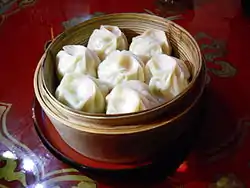Mongolian cuisine
Mongolian cuisine predominantly consists of dairy products, meat, and animal fats. The most common rural dish is cooked mutton. In the city, steamed dumplings filled with meat—"buuz"— are popular.

The extreme continental climate of Mongolia has influenced the traditional diet. Use of vegetables and spices are limited. Due to geographic proximity and deep historic ties with China and Russia, Mongolian cuisine is also influenced by Chinese and Russian cuisine.[1]
Features
The nomads of Mongolia sustain their lives directly from the products of domesticated animals such as cattle, horses, camels, yaks, sheep, and goats, as well as game.[1] Meat is either cooked, used as an ingredient for soups and dumplings (buuz, khuushuur, bansh, manti), or dried for winter (borts).[1] The Mongolian diet includes a large proportion of animal fat which is necessary for the Mongols to withstand the cold winters and their hard work. Winter temperatures are as low as −40 °C (−40 °F) and outdoor work requires sufficient energy reserves. Milk and cream are used to make a variety of beverages, as well as cheese and similar products.[2]
The nomads in the countryside are self-supporting on principle. Travelers will find gers marked as guanz in regular intervals near the roadside, which operate as simple restaurants. In the ger, which is a portable dwelling structure (yurt is a Turkic word for a similar shelter, but the name is ger in Mongolian), Mongolians usually cook in a cast-iron or aluminum pot on a small stove, using wood or dry animal dung fuel (argal).
Common foods
The most common rural dish is cooked mutton, usually without any other ingredients. To accompany the meats, vegetables and flour products may be used to create side dishes as well. In the city, every other local displays a sign saying "buuz". Those are steamed dumplings filled with meat. Other types of dumplings are boiled in water (bansh, manti), or deep fried in mutton fat (khuushuur). Other dishes combine the meat with rice or fresh noodles made into various stews (tsuivan, budaatai khuurga) or noodle soups (guriltai shöl).

 Boiled meat and innards; the most common meal in a herder's household
Boiled meat and innards; the most common meal in a herder's household
 Another Buuz variant
Another Buuz variant Khorkhog
Khorkhog Boodog
Boodog
The most surprising cooking method is only used on special occasions. In this case, the meat (often together with vegetables) gets cooked with the help of stones, which have been preheated in a fire. This either happens with chunks of mutton in a sealed milk can (khorkhog), or within the abdominal cavity of a deboned goat or marmot (boodog).
Milk is boiled to separate the cream (öröm, clotted cream).[2] The remaining skimmed milk is processed into cheese (byaslag), dried curds (aaruul), yogurt, kefir, and a light milk liquor (shimiin arkhi). The most prominent national beverage is airag, which is fermented mare's milk.[2] A popular cereal is barley, which is fried and malted. The resulting flour (arvain guril) is eaten as a porridge in milk fat and sugar or drunk mixed in milky tea. The everyday beverage is salted milk tea (süütei tsai), which may turn into a robust soup by adding rice, meat, or bansh. As a result of the Russian influence during socialism, vodka has also gained some popularity[2] with a surprising number of local brands (usually grain spirits).Boortsog or bawïrsaq is a type of fried dough food found in the cuisines of Central Asia, Idel-Ural, Mongolia and the Middle East. It is shaped into either triangles or sometimes spheres. The dough consists of flour, yeast, milk, eggs, margarine, salt, sugar, and fat.
 Süütei Tsai, salted milk tea
Süütei Tsai, salted milk tea Three large stones removing excess liquid from a cheese, Khövsgöl Province
Three large stones removing excess liquid from a cheese, Khövsgöl Province A glass of airag in front of the plastic barrel used to make it
A glass of airag in front of the plastic barrel used to make it Leather pouch used for fermenting airag the traditional way
Leather pouch used for fermenting airag the traditional way.jpg.webp) Various types of mongolian sour milk sweets
Various types of mongolian sour milk sweets Aaruul in the process of drying on top of a ger
Aaruul in the process of drying on top of a ger Aaruul in a serving bowl
Aaruul in a serving bowl Boortsog type of fried dough
Boortsog type of fried dough
Horse meat is eaten in Mongolia and can be found in most grocery stores.
Mongolian sweets include boortsog, a type of biscuit or cookie eaten on special occasions.
Vodka is the most popular alcoholic beverage; Chinggis vodka (named for Genghis Khan) is the most popular brand, making up 30% of the distilled spirits market.[3]
| Wikimedia Commons has media related to Cuisine of Mongolia. |
References
- Marshall Cavendish Corporation, 2007, p. 268
- Marshall Cavendish Corporation, 2007, p. 269
- "CHINGGIS Vodka". www.behindcity.com. Retrieved 19 March 2018.
- Marshall Cavendish Corporation (2007) World and Its Peoples: Eastern and Southern Asia, Marshall Cavendish, p. 268 -269 ISBN 0-7614-7633-4

